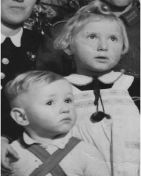Act I, scenes i–iv
Analysis: Act I, scenes i-iv
These scenes establish the play’s dramatic premise—the witches’ awakening of Macbeth’s ambition—and present the main characters and their relationships. At the same time, the first three scenes establish a dark mood that permeates the entire play. The stage directions indicate that the play begins with a storm, and malignant supernatural forces immediately appear in the form of the three witches. From there, the action quickly shifts to a battlefield that is dominated by a sense of the grisliness and cruelty of war. In his description of Macbeth and Banquo’s heroics, the captain dwells specifically on images of carnage: “he unseamed him from the nave to th’ chops,” he says, describing Macbeth’s slaying of Macdonald (I.ii.22). The bloody murders that fill the play are foreshadowed by the bloody victory that the Scots win over their enemies.
Our initial impression of Macbeth, based on the captain’s report of his valor and prowess in battle, is immediately complicated by Macbeth’s obvious fixation upon the witches’ prophecy. Macbeth is a noble and courageous warrior but his reaction to the witches’ pronouncements emphasizes his great desire for power and prestige. Macbeth immediately realizes that the fulfillment of the prophecy may require conspiracy and murder on his part. He clearly allows himself to consider taking such actions, although he is by no means resolved to do so. His reaction to the prophecy displays a fundamental confusion and inactivity: instead of resolving to act on the witches’ claims, or simply dismissing them, Macbeth talks himself into a kind of thoughtful stupor as he tries to work out the situation for himself. In the following scene, Lady Macbeth will emerge and drive the hesitant Macbeth to act; she is the will propelling his achievements. Once Lady Macbeth hears of the witches’ prophecy, Duncan’s life is doomed.
Macbeth contains some of Shakespeare’s most vivid female characters. Lady Macbeth and the three witches are extremely wicked, but they are also stronger and more imposing than the men around them. The sinister witches cast the mood for the entire play. Their rhyming incantations stand out eerily amid the blank verse spoken by the other characters, and their grotesque figures of speech establish a lingering aura. Whenever they appear, the stage directions deliberately link them to unease and lurking chaos in the natural world by insisting on “Thunder” or “Thunder and lightning.”
Shakespeare has the witches speak in language of contradiction. Their famous line “Fair is foul, and foul is fair” is a prominent example (I.i.10), but there are many others, such as their characterization of Banquo as “lesser than Macbeth, and greater” (I.iii.63). Such speech adds to the play’s sense of moral confusion by implying that nothing is quite what it seems. Interestingly, Macbeth’s first line in the play is “So foul and fair a day I have not seen” (I.iii.36). This line echoes the witches’ words and establishes a connection between them and Macbeth. It also suggests that Macbeth is the focus of the drama’s moral confusion.





